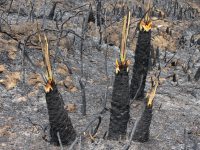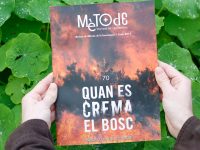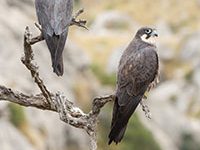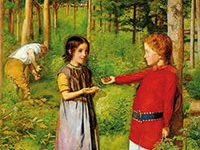
Fire requires three elements: ignition, oxygen and fuel. All three are present in terrestrial ecosystems, thus fire has become a component of environments. The Mediterranean ecosystem’s adaptation to fire is evident, and is also due to human influence spanning thousands of years.
«There is more and more evidence that the burning of undergrowth is a natural process that has occurred in nature for millions of years»
Traditionally, forest fires have been considered a destructive process in terms of the ecosystem; an ecological disaster. This negative view of fires is held both by the average individual and many environmental professionals. The understanding is based on the fact that fires are caused by humans and, therefore, under «natural» conditions (without humans) they should not occur. It is also based on the post-fire ecosystem («the disaster»), rather than on a dynamic, medium and long-term point of view. However, there is more and more evidence that the burning of undergrowth is a natural process that has occurred in nature for millions of years, probably since land plants appeared. During the history of life, fires have helped to form the nature and character of plants, community structure, biomass distribution and flower diversity.
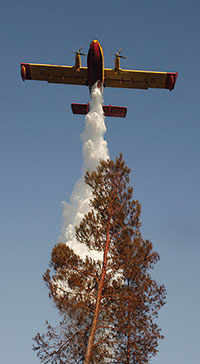
Although fires are part of the natural cycle, human action has disrupted the fire regime, which can have negative consequences for biodiversity. / M. Lorenzo
Indeed, the appearance of humans has led to changes in fire regimes in many ecosystems, both increasing the frequency (through arson) and intensity, while decreasing their extension at the same time (by extinguishing naturally caused fires). This departure from historical fire regimes can have negative consequences for biodiversity. However, as discussed throughout the article, this fact does not mean –and is far from it– that fires are not a natural process in our ecosystems or that they are negative for biodiversity.
A burning past
Fire requires three components: ignition, oxygen and fuel. There have always been sources of ignition on our planet (lightning, volcanoes…). Fuel appeared during the Silurian (450 million years ago) with the colonisation of terrestrial life by means of plants, which are also the source of oxygen in the biosphere. Fossil coals have been found indicating the existence of fire from the advent of terrestrial plants, and there is a large accumulation of fossil carbon during the Carboniferous (359 million years ago). In fact, during this era oxygen concentrations reached very high levels (about 31%, compared to 21% today), a condition that created plant flammability in wet conditions, something that would currently make burning difficult. Then, throughout the history of life, the fire regime has changed, both due to climate change and changes in the fauna (fuel consumers) and, during recent history, due to human-related changes (socio-economic changes, ecosystem management, and so on). But it is clear that fire has always existed during the evolutionary history of plants and therefore it can be expected that many plants have acquired characteristics and strategies that enable them to live in areas that burn frequently. Moreover, it is currently believed that the explosion and dominance of angiosperms during the Cretaceous (between 145 and 65 million years ago) was possible due to recurrent fires.
«Plants growing in environments with high fire frequency have acquired a number of functional characteristics during their evolution, enabling them to persist and reproduce in environments suffering repeated fires»
Fire has a strong impact on plants, destroying most of their aerial tissues. The long history of fires has meant plants have adopted strategies to survive and reproduce in the aftermath. Taxa with characteristics enabling them to regenerate better after a fire compared to other taxa (e.g., more heat-resistant seeds or fruits) can take advantage of post-fire regeneration conditions (where there is little competition and many resources available) and therefore increase the number of progeny, allowing them to take over or displace (higher biological efficiency) other taxa that are less well-adapted to fire. Therefore, fire acts as a selection pressure and is a biodiversity generating process. In fact, many Mediterranean areas, where intense crown fires are frequent, correspond to hot biodiversity spots (the Mediterranean, South Africa, Mediterranean areas of Australia), namely, with exceptional species richness.
Fire occurs in almost all ecosystems throughout the world because there is often lightning (which commonly occurs in dry periods) coinciding with combustible biomass almost everywhere. Even in dry areas, such as in central Australia, ecosystems cannot be understood without fire. The major importance of fires worldwide makes them one of the most significant processes for understanding global CO2 and nutrients cycles. The main difference is that the fire regime varies from one ecosystem to another. For example, areas in which fires are more frequent are tropical savannas, where intervals between fires can be one to five years. This high recurrence enables the accumulation of a lot of flammable biomass and fires in these systems are of low-intensity. In contrast, in boreal areas, fires are infrequent, at ten- or even hundred-year intervals, however, when they do happen, their intensity is extremely high. Mediterranean ecosystems are in an intermediate situation, with just over a ten-yearly frequency. It is true that humans have increased the occurrence of fires, but they have also reduced their extension due to land fragmentation (agriculture and urbanisation) and extinguishing. By managing forests, humans have also changed the types of fires. For example, the prevention and extinguishing of fires in typical areas of surface fires has reduced fire frequency, but when a fire does occur, it is much more intense due to increased accumulation of combustible material.
Fire-adapted Mediterranean flora
Plants growing in environments with high fire frequency have acquired a number of functional characteristics during their evolution, enabling them to persist and reproduce in environments suffering repeated fires. These characteristics, therefore, have an adaptive value. Most fires in Mediterranean ecosystems, whether forest or bush fires, are so-called crown fires, in other words, those affecting the whole aerial part of the plant. In these environments, the main features that are selected are those related to the ability to grow again and the ability to grow in profusion after the fire. In ecosystems suffering ground fires, the characteristics that confer persistence are tree bark thickness and ability to resprout from the undergrowth. Currently, ground fires are rare in the Mediterranean basin, partly due to fire prevention and extinguishing policies, which lead to a significant accumulation of biomass. These stands of biomass mean fire can spread easily from the surface to the crown and generate more intense fires.

Among dead tree trunks we found pine needles and pine cones. The former protects the soil, while the latter carries the seeds of new plants, to grow after the fire. / A. Cerdà, Universitat de València/J. Maraix-Solera
A plant’s ability to resprout after being completely burnt by fire is an essential feature for persistence in areas with frequent fires. This feature not only allows the persistence of populations, but also of specimens, because a part of the plant (typically the underground part) does not die. It is not a unique characteristic of Mediterranean ecosystems or of ecosystems with recurrent fires, but is even observed in many species in communities that rarely burn (for example, tropical rain forests, cold temperate ecosystems, desert areas, etc.). The traditional belief that fire is a relatively new factor, along with the pervasiveness of regrowth capacity, has promoted the understanding that regrowth is not considered an adaptation to fire, but an adaptation to other common disturbances throughout history (strong winds, herbivory, drought). However, current knowledge of the long history of fires on Earth suggests that fire has also helped to model regrowth, at least in some species.
«There is no doubt that certain types of regrowth in some lineages are mainly due to the history of fires»
In fact, a plant’s ability to resprout is a rather complex feature, as there are different mechanisms and each may be related to different natural selection pressures. Some species sprout from internal buds, strongly protected by the bark. Selection of this feature is associated with protection against the high temperatures produced by fire. Other species sprout from lignified basal tubers (lignotubers), structures exclusive of species growing in environments subjected to recurrent fires. In addition, many resprouting plants store large amounts of reserve substances in the roots to regenerate biomass rapidly. This represents a high cost for plants, which seems unnecessary as a mere adaptation to herbivory, at least in woody plants. The ability to resprout is an ancestral trait seen in many ancient species (ferns and primitive conifers), although in some cases it has been acquired secondarily (like in some pines), and coincides in species living in environments with recurrent fires. Currently, studies are underway to try to more accurately assess the role of fire in the evolution of an ability to resprout, but there is no doubt that certain types of regrowth in some lineages are mainly due to the history of fires.
The ability of new specimens to thrive after a fire is another very common feature in Mediterranean environments, conferring persistence of populations in areas with recurrent fires. This ability occurs in plants that accumulate a seed bank (either in the soil or crown) that is resistant to intense heat. In fact, the fire stimulates this accumulation by various species-dependent processes: heat breaks seed dormancy (mainly in species with hard waterproof seeds); smoke stimulates germination and seedling growth (mainly in species with permeable seeds); and heat stimulates seed dispersion (in species with aboveground seed banks, i.e. serotinous species). Through these processes, populations are restored quickly in the clearings opened up by fires and often increase the population, as compared to pre-fire conditions.
As populations suffering fires are favoured (leaving more progeny), many species have acquired characteristics making them highly flammable. In fact, there is an evolutionary correlation between flammability and ability to thrive after fire. This ability to incorporate new specimens quickly and prolifically after a fire is almost exclusive of Mediterranean ecosystems, and has no doubt been acquired through selection pressure, generated by recurrent fires. Furthermore, the fact that specimens die and quickly produce progeny means they acquire new traits and, therefore, diversify, which explains why many of the biodiversity hotspots in the world are areas with frequent fires. In the Mediterranean basin, the diversification of many lineages can certainly be linked to recurrent fires, as might be the case of Cistaceae and some lineages of legumes and Labiatae, among others. This relationship between diversity and fire is even more evident in other Mediterranean climate zones, such as in the South African or Australian bushland.
In Mediterranean ecosystems with crown fires, plants can have one of these two regeneration mechanisms after a fire (resprouting species and germinating or recruiting species) or both simultaneously (optional species). There are also species that have neither of these regeneration mechanisms and the populations disappear after the fire. Some of them recolonise rapidly (species with high seed production and an efficient dispersal mechanism) and others do so very slowly. In the Mediterranean basin, the ability to resprout and recruit shows a negative evolutionary correlation, i.e., there are lineages dominated by resprouting species (Fagaceae or Rhamnaceae) and lineages dominated by species that thrive after fire (Cistaceae), but lineages having both resprouting species and germinating species are more rare (some Ericaceae and Fabaceae). In fact, in the Mediterranean basin, species’ ability to recruit after fire is an evolutionarily trait acquired at a later date than the ability to resprout (which is ancestral) and is mainly acquired in lineages that do not have a resprouting ability.
In ecosystems with surface fires, tree species with thick bark dominate as the bark protects vital tissues from the heat of fire. Small differences in the bark thickness, especially in the basal part of the trunk, may determine the survival of the tree in a surface fire, and therefore specimens with thick bark are selected. Thus, it appears that pine species growing in areas with surface fires have much thicker bark than pine species growing in areas of crown fires, where this feature would not be an advantage. Even within the same species, populations living in areas with surface fires tend to have thicker bark than populations in areas with crown fires. A special case of a thick insulating bark is that of the cork oak (Quercus suber). It is hard to imagine a scenario where such insulating material for tree bark were to be selected, were it not for the presence of recurrent fires during the species’ history. There are other species, including distant lineages, which have thick and strongly suberised bark similar to oak. All of them live in areas with frequent fires around the world (a clear case of convergent evolution).
Humans in a flammable world
Human origin is strongly linked to fire. Homo erectus was the first species to control fire, and evolutionto Homo sapiens was prompted by fire. Cooked food consumption increased the amount of proteins and carbohydrates in the diet and diet diversity and therefore gave them an advantage over other hominids not using fire. In addition, cooking forced the development of social skills typical of humans. For example, collection for individual and immediate consumption evolved to the harvesting and subsequent cooking and collective consumption. That, in turn, led to the allocation of tasks such as collecting and storing food, surveillance (and stealing) of stored food, cooking, and the social act of sitting around the fire eating and talking. All this influenced evolution of both physical characteristics (smaller teeth and jaws) and social characteristics. Cooking meant a longer life expectancy, not only due to greater food availability but also the consumption of soft food enabled life to go beyond the time when teeth were no longer strong. In turn, increasing females’ life expectancy beyond their reproductive lifespan made it possible for them to care for grandchildren, thus reducing child mortality (the so-called «grandmother effect»), further increasing the biological efficacy of humans through the use of fire. Fire was also extremely important as a defensive weapon against predators and enemies, and made it possible to colonise cold environments when they left Africa. The more primitive hominids did not know how to make fire, so they preserved it (and fought for it) as a precious treasure. The exact time they learned how to make fire is still under debate, but there is evidence of bonfire remains in East Africa dating back a million and a half years, and some clearer evidence in the Middle East going back 800,000 years.
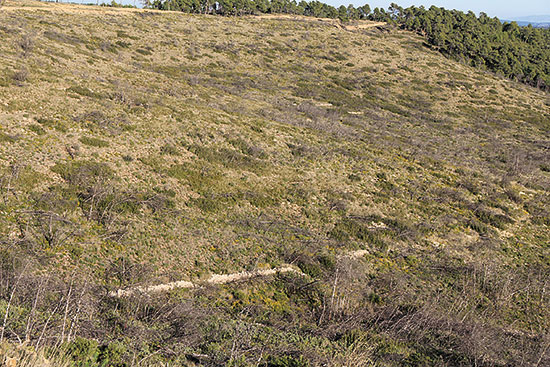
An example of natural recovery after a fire. Navalón (Valencia, Spain), in the Enguera mountains, after a fire in 2008. The picture was taken two years later. / A. Cerdà/Universitat de València
Once humans had managed to control fire, they began to use it for myriad purposes, like burning vegetation to produce tender shoots, hunting, clearing pastures, fighting between settlements… Agricultural development was also helped by the use of fire. In fact, it is believed that one of the reasons why agriculture emerged and expanded rapidly in the Mediterranean was the ease of burning (deforesting) in these environments. Indeed, the fire regime changed over history due to human-associated burning and landscape fragmentation (and that of fuel) and the expansion of agriculture and settlements, reducing the frequency in some places and increasing it in others. These population increases and land-use changes took place during the Holocene, in parallel with increased drought, characteristic of that period. It is uncertain to what extent changes in the fire regime are directly due to human activity or climate change. Probably both factors played a part in forming the fire regime of this period. How our landscape and fire would be without humans is difficult to imagine, if not impossible, because fires and humans have coexisted for so long and have been subjected to climatic changes. With industrialisation and modernisation of society, there was a drastic change in the landscape and fire regime of the Mediterranean basin. Up until then, it was subjected to great farming and livestock pressures, and an intensive use of mountainous lands. The abandonment of agriculture and livestock, during the late twentieth century, led to increased fuel accumulation and its spatial continuity. The proliferation of tree plantations, especially conifers, as well as fire-fighting and prevention policies have contributed to the increase of flammable vegetation. This drastic change –perhaps similar to past extinctions of large herbivores– together with the increase of fires inherent to increased population density, as well as temperature rise (due to the greenhouse effect), have all generated an increase in the extension and frequency of fires in many of our landscapes over the last forty years. This increase has occurred despite a parallel increase in efforts to control and extinguish fires. In some areas, this has had an impact on biodiversity. For example, Aleppo pine is a serotinous species, well adapted to fire when the fire intervals are sufficiently far apart to enable an adequate pine seed bank to accumulate. Excessively high frequencies (for instance, intervals of less than twenty years) prevent the survival of this species; a clear example of the fact that species are not adapted to fire in general, but rather to certain fire regimes.
«There is no doubt that certain types of regrowth in some lineages are mainly due to the history of fires»
There is no doubt that there are certain natural fire regimes characteristic of certain ecosystems and that part of our ecosystems’ diversity is explained by the existence of consistent and predictable fires. However, it is also true that there are areas suffering fire regimes outside the natural range, and this is having serious ecological consequences. The aim of forest management should not be to eliminate fires, not only because it is virtually impossible but because it is also unnatural. Rather, we should accept certain sustainable fire regimes and learn to live with them. Our society’s challenge is to know how to manage our lands and ecosystems so as to reduce fire-related hazards that endanger lives and infrastructures, and seek to establish environmentally sustainable regimes.
Basic conceptsWildfire: Uncontrolled fire in natural areas, the fuel being vegetation (forests, scrub, etc.). Fire Ecology: A branch of ecology (and therefore a science) that studies the relationship between fire and organisms and the environment, at different spatial and temporal scales. Specifically, fire ecology seeks to understand the role of fire in species’ evolution and structure of populations, communities, ecosystems and biomes. It is based on the concepts of ecology and evolution of species. It studies both natural fires (e.g., regeneration studies) and experimental fires. Fire regime: A set of characteristics of fires in a given area or ecosystem, especially in reference to the frequency (or interval between fires), intensity, seasonality and type. In fact, the species are not adapted to fire itself, but to a particular fire regime (e.g., a particular combination of frequency, seasonality, intensity and type). There are three main types of fires that determine different fire regimes: crown fires, surface fires and ground fires. In some cases, intermediate types (mixed regimes). Crown fires (or stand-replacement fires): Fire affecting almost all the crown or aerial parts of plants. Also called stand-replacement because regeneration replaces the vegetation (but often being the same species). This regime is typical of Mediterranean shrub (scrub, garrigue, maquis) and relatively dense forests (oak, white pine woods…). There are also crown fires in boreal forests, but with lower frequencies and higher intensities than in the Mediterranean ecosystems. In ecosystems with crown fires and a relatively high frequency (Mediterranean scrub), resprouting species and species with a high recruiting ability prevail. Surface fires (or undergrowth fires): The fire almost only affects the undergrowth. They are typically low-intensity fires but very frequent. They occur in relatively open forests, such as savannas and some coniferous forests of the Mediterranean mountains (European black pine forests, Pinus nigra). Typical of these systems are trees with thick bark and resprouting herbaceous undergrowth. Ground fires: These fires do not generate flames on the surface, but they burn underground and are typical in peat lands. Mainly observed in boreal areas and rare in Mediterranean conditions. Serotiny: It refers to the ability to retain seeds in the crown for a few years and release them after the fire to take advantage of post-fire conditions (high resources, low competition). The typical example of a species of the Mediterranean serotiny is the Aleppo pine (Pinus halepensis), which retains closed cones (serotinous cones) for several years, which then open with the heat of a fire, whereby after a fire many seeds are spread and there is a high specimen recruitment. Therefore, the Aleppo pine is a species adapted to fire, at least to fire regimes with fire intervals of at least the age of mature pines (higher frequencies prevent seed production and therefore pine regeneration). |
REFERENCES
Bond W. J. & A. C. Scott, 2010. «Fire and the Spread of Flowering Plants in the Cretaceous». New Phytologist, 188: 1137-1150.
Bond W. J. & B. W. Van Wilgen, 1996. Fire and Plants. Chapman & Hall. London.
Pausas J. G. & J. E. Keeley, 2009. «A Burning Story: The Role of Fire in the History of Life». Bioscience, 59: 593-601.
Pausas J. G. & R. Vallejo, 2008. «Bases ecológicas para convivir con los incendios forestales en la región mediterránea. Decálogo». Ecosistemas, 17: 128-129.
Pausas J. G. & M. Verdú, 2005. «Plant Persistence Traits in Fire-prone Ecosystems of the Mediterranean Basin: a Phylogenetic Approach». Oikos, 109: 196-202.

